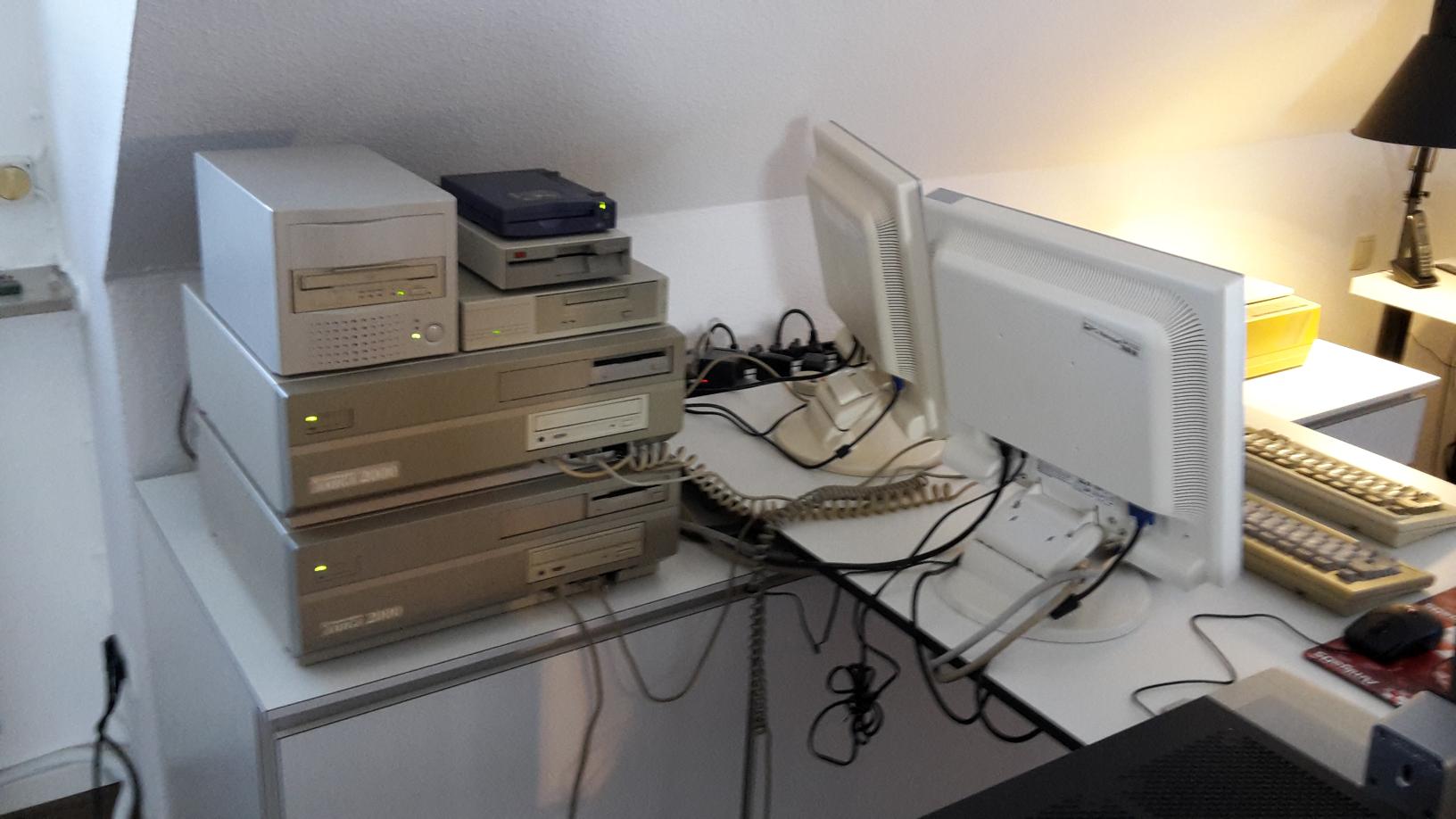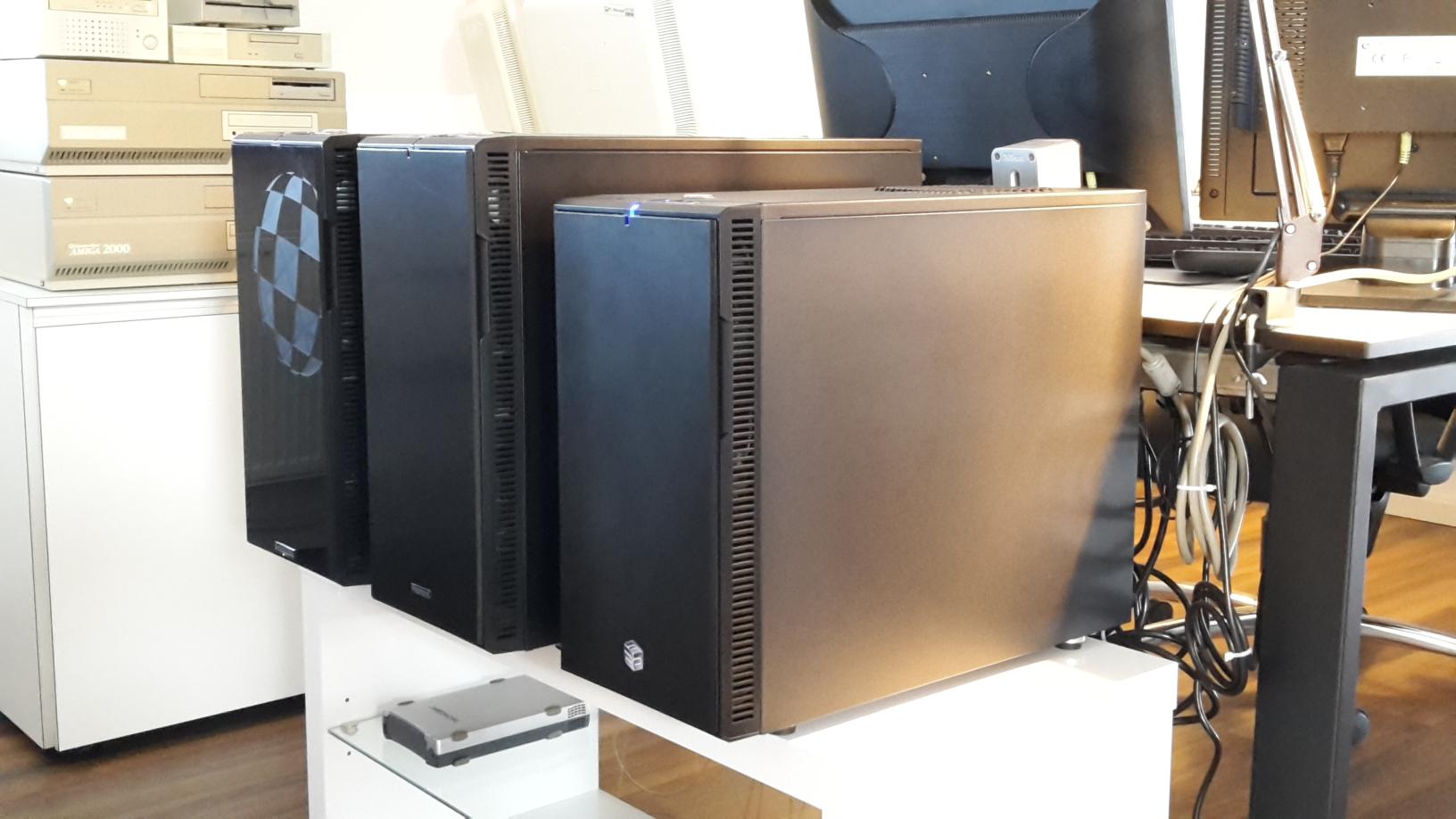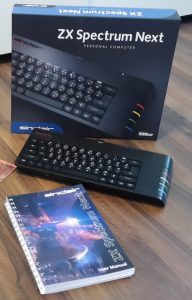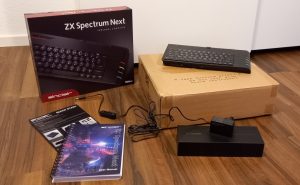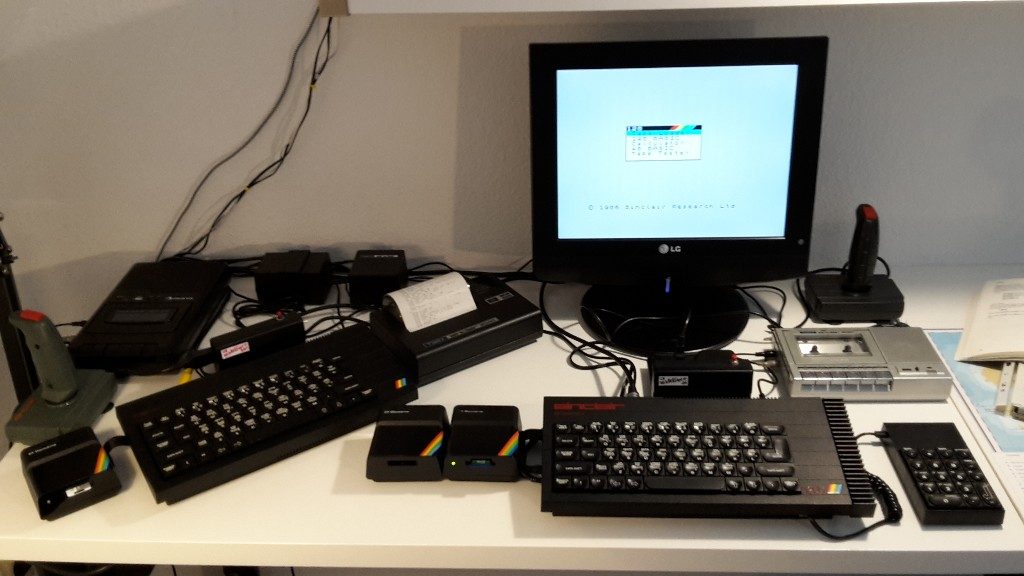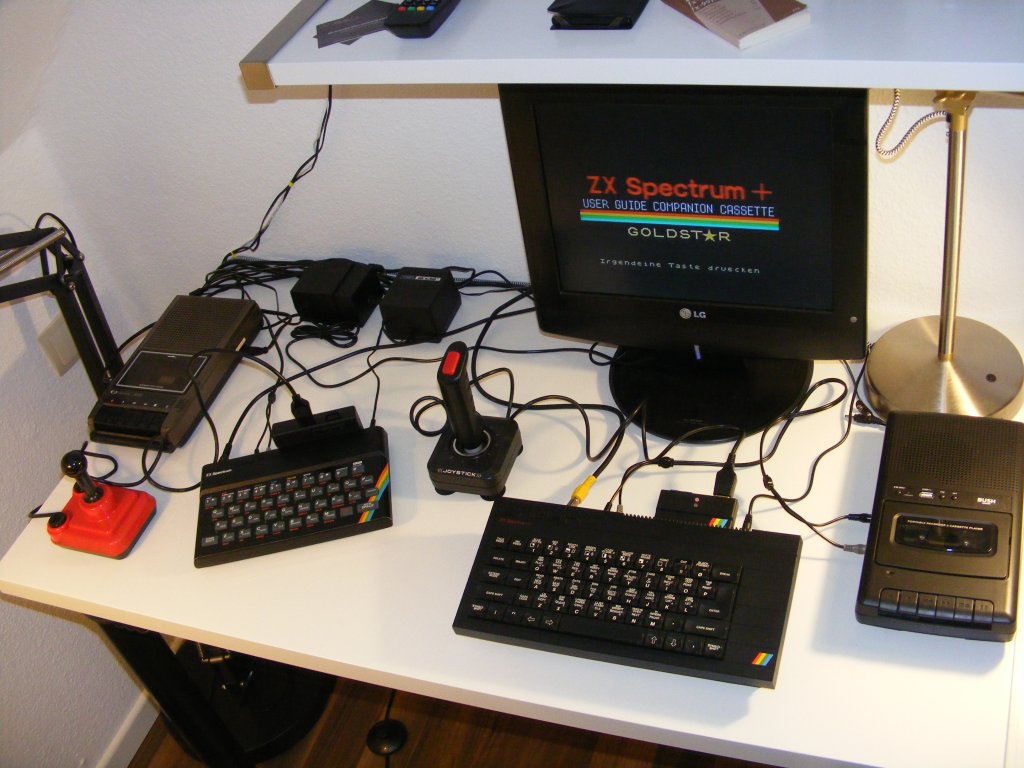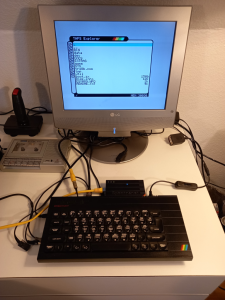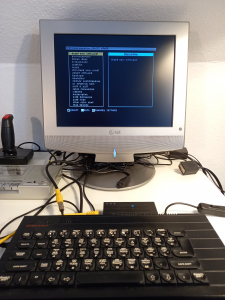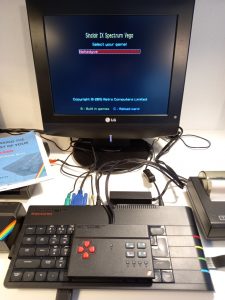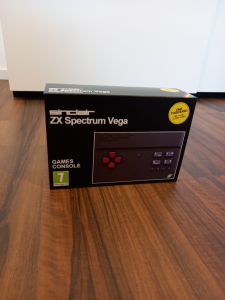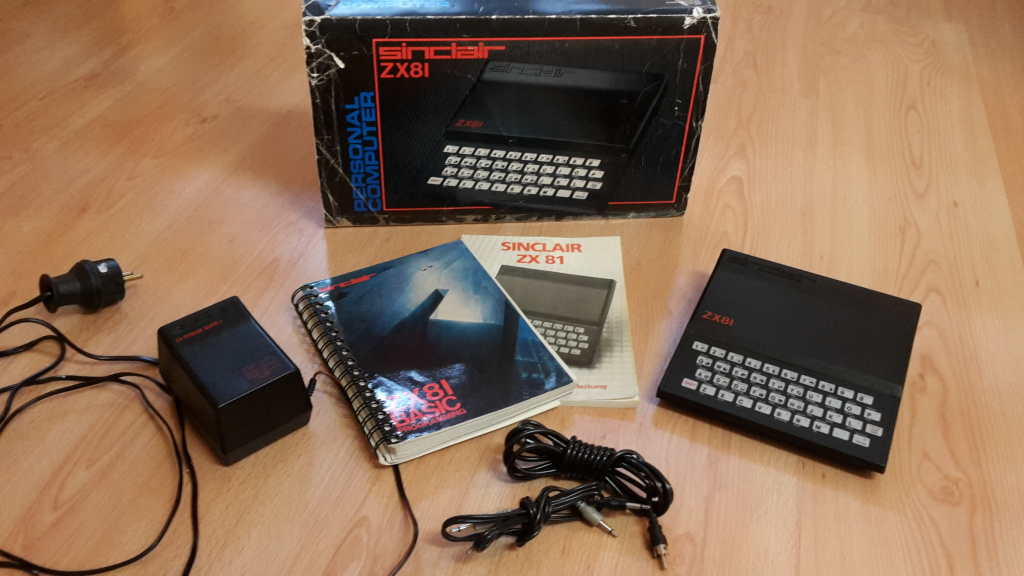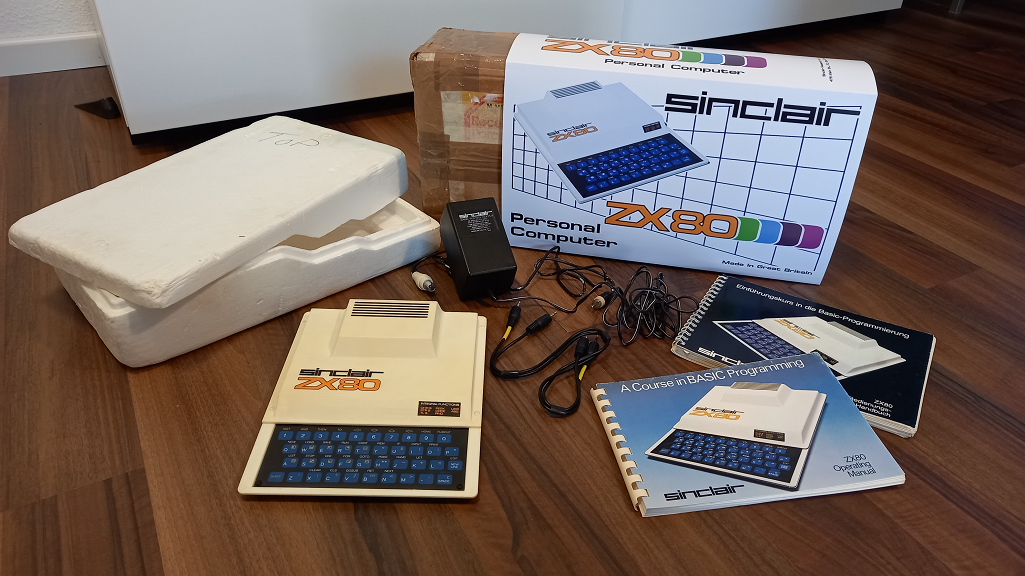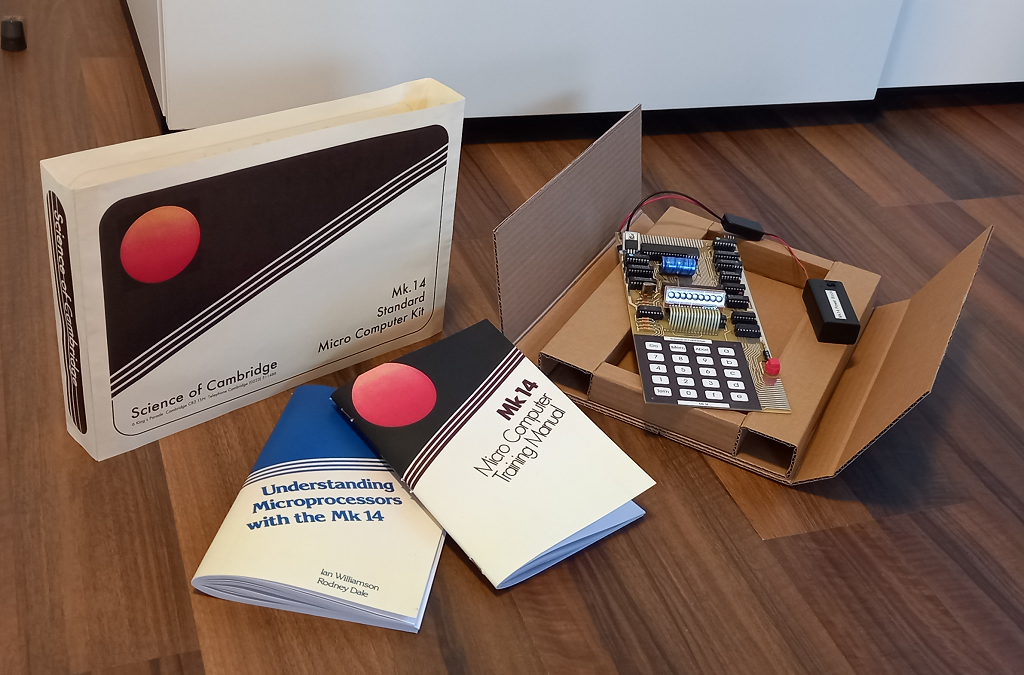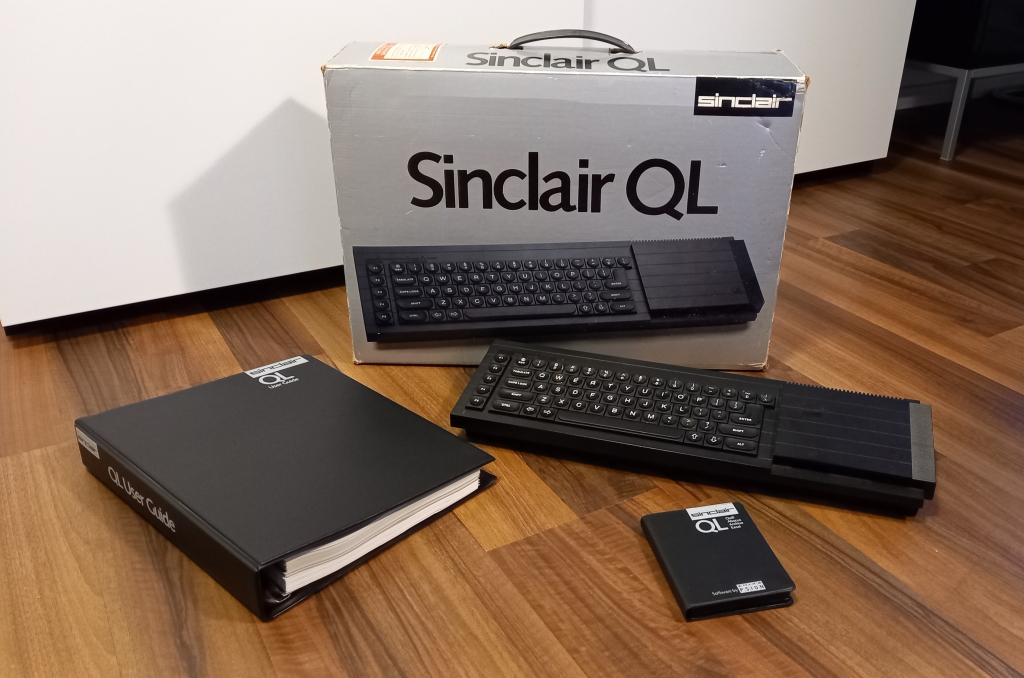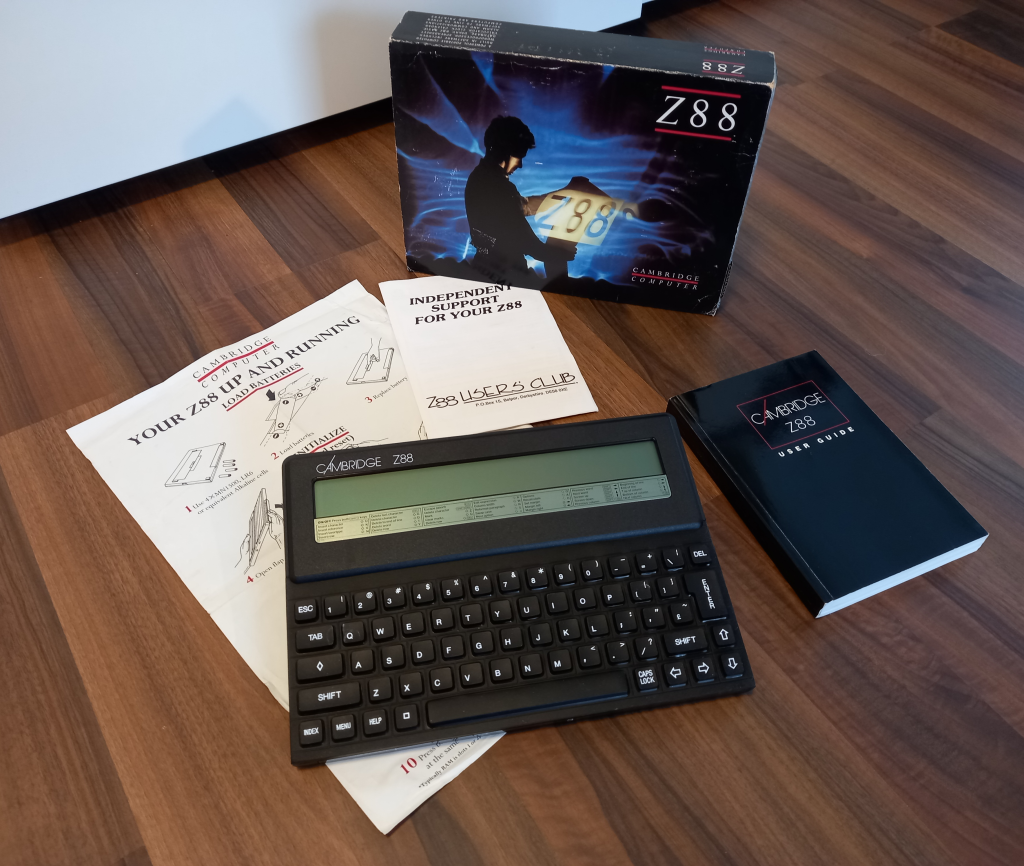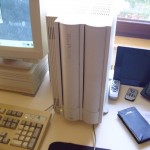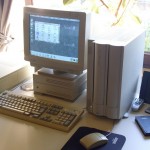Commodore Amiga Systems
For many years this Commodore Amiga 2000 machines were my main work systems. Furthermore there is an Amiga 1000 somewhere in the attic – sorry, no photos yet.
Bottom System: Commodore Amiga 2000 (Rev. 6.x)
• 1 MB ChipRAM
• Blizzard 2060 (Motorola XC68060, 50 MHz/64 MB FastRAM/FastSCSI-Controller)
• DeInterlace A2000
• CyberVision 64/3D (4 MB VRAM)
• Multiface III Interface Card
• HydraSystems AmigaNet Ethernet Card
• ASDG Twin-X/GPIB Interface Card
• internal SCSI: Codesrc SCSI2SD, 4 GB Panasonic SD, Pioneer 12xCD-ROM
• external SCSI: 2 GB Hewlett Packard Surestore, Yamaha CDR-100 2xCD Writer (optional: ScanMagic 9636S Scanner)
• external GPIB: Sharp JX-300 Scanner
• OS: AmigaOS 3.2.2 (Picasso96)
Upper System: Commodore Amiga 2000 (Rev. 4.x)
• 0,5 MB ChipRAM/0,5 MB SlowRAM
• Blizzard 2040 (Motorola MC68040, 40 MHz/60 MB FastRAM/FastSCSI-Controller)
• A2320 Deinterlace Card
• SupraRAM 2000 (2 MB FastRAM)
• Picasso II (1 MB VRAM)
• Multiface III Interface Card
• HydraSystems AmigaNet Ethernet Card
• internal SCSI: Codesrc SCSI2SD, 4 GB Panasonic SD, Toshiba 4xCD-ROM
• external SCSI: Iomega Zip 100, Hewlett Packard HP35470A DAT-Streamer
• external FD: 5,25″ TEAC Floppy Disk Drive
• OS: AmigaOS 3.2.2 (Picasso96)
No Photo: Commodore Amiga 1000
• 0,5 MB ChipRAM
• Motorola MC68000, 7 MHz
• Golem RAMBox (1MB FastRAM)
• external: A1010 3,5″ Disk Drive
• OS: AmigaOS 1.3
Next Generation AmigaOS Systems
Since 2009 I mainly use the following so-called „Next Generation“ (aka PowerPC) systems as my primary AmigaOS workhorses.
Right System: ACube SAM440ep (Mini-ITX)
• AMCC 440ep 667 MHz
• Radeon M9 (64 MB VRAM)
• 512 MB RAM
• Case: Fractal Design Define Mini
• internal SATA: 160 GB Samsung Spinpoint (2,5″)/Sony Optiarc Slimline DVD Writer
• external USB: A-Eon AmigaONE-Keyboard & -Mouse, Medion 250 GB Harddisk
• OS: AmigaOS 4.1 Final Edition Update 2
Middle System: BPlan Pegasos II
• Apollo 74×7 G4 1 GHz
• Radeon 9250 (128 MB VRAM)
• 1 GB RAM
• sii3512-SATA-Controller
• Hama VIA-USB 2.0 Card
• Case: Fractal Design Define R2 (incl. Do-it-yourself reset button)
• internal ATA: 80 GB WesternDigital Caviar/LG SuperMulti DVD Writer
• internal ATA: ATA-SATA-Adaptor connected 640 GB WesternDigital Caviar
• internal SATA:160 GB Samsung Spinpoint
• external PS/2: A-Eon AmigaONE-Keyboard & -Mouse
• external serial: Wacom Artpad
• OS: AmigaOS 4.1 Final Edition Update 2\MorphOS 3.18\Xubuntu Intrepid Ibex 8.10
Left System: A-Eon AmigaONE X1000
• PWRficient PA6T-1682M 1.8 GHz
• Sapphire RadeonHD 6570 (1GB VRAM)
• 2 GB RAM
• Hercules Muse LT CMI8738 Sound Card
• Realtek RTL8139 Ethernet Adapter
• Case: Fractal Design Define R3 (A-Eon customized)
• internal SATA: 1 TB WesternDigital Caviar/TSST SuperWritemaster DVD Writer
• external USB: A-Eon AmigaONE-Keyboard & -Mouse, Hama 35-in-1 Card Reader
• OS: AmigaOS 4.1 Final Edition Update 2
Sinclair Systems
My oldest hardware and software platform. These were the times…when digital pioneers began their 8-bit life. Beneath playing games (of course) I learned programming BASIC and Z80 assembler with this computer. And everything else someone can do with a computer system: pixel art work, generating sounds, using database software or word processors, print text or graphics. A whole new universum of creativity for us…
In February 2020 a brand new Sinclair ZX Spectrum was released: the Sinclair ZX Spectrum Next. Three years later the second Kickstarter campaign ended successfully: A new, updated, Sinclair ZX Spectrum Next arrived.
Left System: Sinclair ZX Spectrum Next + Accelerated (Issue 2B „Next“)
• TBBlue Z80N 3.5/7/14/28 MHz
• 2048 KB RAM
• 8 GB Gigastore SD
• Raspberry Pi Zero Accelerator /w NextPi 1.92D
• ESP8266-01 Wifi module
• DS1307 IC RTC module
• external PS/2: Perixx PERIMICE-201II PB mouse
• Timex Computer TC2010 Computer Program Recorder
• OS: System/Next 23.06 /w NextBASIC/NextΖΧOS 2.08\Sinclair BASIC\ Sinclair Extended BASIC\esxDOS 0.8.9 /w TR-DOS 5.04T\CP/M v3
Right System: Sinclair ZX Spectrum Next + Accelerated (Issue 4 „Nextwo“)
• TBBlue Z80N 3.5/7/14/28 MHz
• 2048 KB RAM
• 8 GB Gigastore SD
• Raspberry Pi Zero Accelerator /w NextPi 1.92D
• ESP8266-01 Wifi module
• DS1307 IC RTC module
• OS: System/Next 23.06 /w NextBASIC/NextΖΧOS 2.08\Sinclair BASIC\ Sinclair Extended BASIC\esxDOS 0.8.9 /w TR-DOS 5.04T\CP/M v3
Left System: Sinclair ZX Spectrum + (Issue 6A „Linda“)
• Zilog Z80 A 3.5 MHz
• 48 KB RAM
• Sinclair ZX Interface 1
• Sinclair ZX Microdrive/vDriveZX, 2 GB Samsung SD
• Sinclair SJS-1 Joystick (grey, ATARI-mod)
• Romantic Robots Multiface One
• Timex/Sinclair 2040 Personal Printer
• Auna RQ-132USB Portable Cassette Recorder
• OS: Sinclair BASIC\Sinclair Extended BASIC (ZX Interface 1)\Toolkit ZX 1.25 (vDriveZX)
Right System: Sinclair ZX Spectrum + 128K (Version 6U „Toasty“)
• Zilog Z80 A 3.5 MHz
• 128 KB RAM
• Sinclair ZX Interface 1
• Sinclair ZX Microdrive
• Sinclair ZX Microdrive/vDriveZX, 4 GB Transcend SD
• Sinclair ZX Interface 2
• Sinclair SJS-1 Joystick (black, ATARI-mod)
• external RS232: Sinclair QL Printer SP-1000QL
• Sinclair ZX Spectrum Keypad (Spanish)
• Romantic Robots Multiface 128
• Timex/Sinclair 2020 Computer Program Recorder
• OS: Sinclair 128 BASIC\Sinclair BASIC\Sinclair Extended BASIC (ZX Interface 1)\Toolkit ZX 1.25 (vDriveZX)
Left System: Sinclair ZX Spectrum 48K (Issue 2 „Mytwo“)
• Zilog Z80 A 3.5 MHz
• 48 KB RAM
• dk’tronics Dual Port Joystick Interface
• Timex/Sinclair 2090 Command Stick
• Elite electronic CR810 Portable Cassette Recorder
• OS: Sinclair BASIC
Right System: Sinclair ZX Spectrum + (Issue 6A „Paul“)
• Zilog Z80 A 3.5 MHz
• 48 KB RAM
• TFW8b.com divMMC Future, 4 GB Platinum SD
• Sinclair SJS-2 Joystick (ATARI-mod)
• Bush CRS-132USB Portable Cassette Recorder
• OS: Sinclair BASIC\esxDOS 0.8.9 /w TR-DOS 5.04T (divMMC Future)
Pictures above: Sinclair ZX Spectrum + (Issue 3 „Kathleen“)
• Zilog Z80 A 3.5 MHz
• 48 KB RAM
• Bytedelight Spectranet Ethernet Interface
• OS: Sinclair BASIC
Pictures above: Sinclair ZX Spectrum Vega
• Freescale MX233 ARM CPU 454 MHz
• 8 MB RAM
• 512 MB Flash RAM
• 8 GB Gigastore SD
• OS: Sinclair BASIC\Sinclair 128 BASIC
Picture above: Sinclair ZX81
• Zilog Z80 A 3.25 MHz
• 1 KB RAM
• Sinclair ZX 16K RAM (additional 16 KB RAM)
• Sinclair ZX Printer
• OS: Sinclair BASIC
Picture above: Sinclair ZX80
• Zilog Z80 A 3.25 MHz
• 1 KB RAM
• Sinclair ZX80 16K Byte RAM Pack (additional 16 KB RAM)
• OS: Sinclair BASIC (8K BASIC ROM Upgrade)
Picture above: Science of Cambridge Mk 14 (Issue V) (Not „Sinclair“, but a Sinclair…)
• National Semiconductor SC/MP (INS8060) 4,4 MHz
• 640 B RAM
• 512 B ROM
• OS: SCIOS ROM V2
Picture above: Sinclair QL
• Motorola MC68008
• 128 KB RAM
• Mircale Systems TrumpCard 2 \w 768 KB RAM
• external Shugart: Miracle Systems 3,5″ Dual Floppy Disc Drive
• (alternative: Miracle Systems Expanderam 512 KB RAM)
• (alternative: Tetroid Disk Interface \w 768 KB RAM \w 8 GB SanDisk CF Card)
• internal: QL-SD w\ 8 GB Gigastore SD
• OS: Sinclair SuperBASIC JS\QDOS 1.10/ToolKit II 2.21 (Trump Card 2)/Minerva ROM v1.98a1 (QL-SD)
Picture above: Cambridge Z88 (No „Sinclair“, nevertheless…)
• Zilog Z80 A (CMOS) 3.2768 MHz
• 32 KB RAM
• Cambridge 512 KB RAM
• Cambridge 128 KB EPROM
• Rakewell 1 MB Flash LED Upgrade
• external RS232: Rakewell Z88 Link | Epson LX-350
• OS: OZ 4.7.1 /w BBC BASIC (Z80) 3.10
Other Systems
Over the years some more hardware found it’s way into my realm. Except the Acorn system most of them are buried somewhere in the attic.
Pictures above: Acorn RiscPC 600
• ARM 610 (33 MHz)
• 1 MB VRAM
• RiscPC 486 Card
• RiscPC Case Upgrade (2nd Slice/100W Power Supply/4xBackplane)
• EtherLan 602 Card
• Storm 16 SCSI Controller
• internal IDE: 420 MB Conner CFS 420A/210 MB Conner CFS 210A
• internal SCSI: 512 MB Fujitsu/Toshiba 4xCD-ROM
• external SCSI: 1.3 GB Seagate ST41600N
• OS: Risc OS 3.5\Windows 95 (486 Card)
…and some portable and stationary Sony PlayStation systems…

